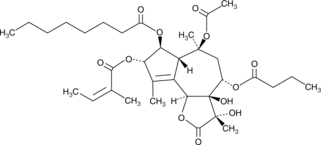Chemicals
Showing 37801–37950 of 41137 results
-
TFAP is an inhibitor of COX-1 (IC50 = 0.8 μM).{52060} It is selective for COX-1 over COX-2 (IC50 = 210 μM). TFAP (10 and 30 mg/kg) reduces acetic acid-induced writhing in mice and has analgesic activity in the formalin test in rats when administered at a dose of 30 mg/kg. It does not induce gastric damage in rats when administered at doses up to 300 mg/kg.
Brand:CaymanSKU:26745 - 10 mgAvailable on backorder
TFAP is an inhibitor of COX-1 (IC50 = 0.8 μM).{52060} It is selective for COX-1 over COX-2 (IC50 = 210 μM). TFAP (10 and 30 mg/kg) reduces acetic acid-induced writhing in mice and has analgesic activity in the formalin test in rats when administered at a dose of 30 mg/kg. It does not induce gastric damage in rats when administered at doses up to 300 mg/kg.
Brand:CaymanSKU:26745 - 25 mgAvailable on backorder
TFAP is an inhibitor of COX-1 (IC50 = 0.8 μM).{52060} It is selective for COX-1 over COX-2 (IC50 = 210 μM). TFAP (10 and 30 mg/kg) reduces acetic acid-induced writhing in mice and has analgesic activity in the formalin test in rats when administered at a dose of 30 mg/kg. It does not induce gastric damage in rats when administered at doses up to 300 mg/kg.
Brand:CaymanSKU:26745 - 5 mgAvailable on backorder
TFMB-R-2-HG is a cell-permeable form of (R)-2-hydroxyglutarate ((R)-2-HG).{42076} (R)-2-HG is structurally similar to α-ketoglutarate and competitively inhibits α-ketoglutarate-dependent dioxygenases, including lysine demethylases and DNA hydroxylases.{26775,26774,26769} TFMB-R-2-HG has been used to assess the role of (R)-2-HG in leukemogenesis.{42076}
Brand:CaymanSKU:20461 -Available on backorder
TFMB-R-2-HG is a cell-permeable form of (R)-2-hydroxyglutarate ((R)-2-HG).{42076} (R)-2-HG is structurally similar to α-ketoglutarate and competitively inhibits α-ketoglutarate-dependent dioxygenases, including lysine demethylases and DNA hydroxylases.{26775,26774,26769} TFMB-R-2-HG has been used to assess the role of (R)-2-HG in leukemogenesis.{42076}
Brand:CaymanSKU:20461 -Available on backorder
TFMB-R-2-HG is a cell-permeable form of (R)-2-hydroxyglutarate ((R)-2-HG).{42076} (R)-2-HG is structurally similar to α-ketoglutarate and competitively inhibits α-ketoglutarate-dependent dioxygenases, including lysine demethylases and DNA hydroxylases.{26775,26774,26769} TFMB-R-2-HG has been used to assess the role of (R)-2-HG in leukemogenesis.{42076}
Brand:CaymanSKU:20461 -Available on backorder
Cdc2-like kinase (Clk), among a number of other kinases, phosphorylates serine/arginine-rich proteins which play a role in alternative splicing of pre-mRNA. The Clk family consists of four members, which include Clk1/Sty and Clk2-4. TG003 is a novel benzothiazole compound that demonstrates potent inhibition of Clk1/Sty and Clk4 with IC50 values of 20 and 15 nM, respectively.{19742} TG003 exhibits considerably weaker inhibition of Clk2 and Clk3 (IC50 = 200 nM and >10 μM, respectively).{19742} Through suppression of Clk-mediated phosphorylation, TG003 inhibits SF2/ASF-dependent splicing of β-globin pre-mRNA at 1 μM in vitro.{19742} At 10 μM, TG003 rescues the embryonic defects induced by excessive Clk activity in Xenopus.{19742}
Brand:CaymanSKU:10398 - 1 mgAvailable on backorder
Cdc2-like kinase (Clk), among a number of other kinases, phosphorylates serine/arginine-rich proteins which play a role in alternative splicing of pre-mRNA. The Clk family consists of four members, which include Clk1/Sty and Clk2-4. TG003 is a novel benzothiazole compound that demonstrates potent inhibition of Clk1/Sty and Clk4 with IC50 values of 20 and 15 nM, respectively.{19742} TG003 exhibits considerably weaker inhibition of Clk2 and Clk3 (IC50 = 200 nM and >10 μM, respectively).{19742} Through suppression of Clk-mediated phosphorylation, TG003 inhibits SF2/ASF-dependent splicing of β-globin pre-mRNA at 1 μM in vitro.{19742} At 10 μM, TG003 rescues the embryonic defects induced by excessive Clk activity in Xenopus.{19742}
Brand:CaymanSKU:10398 - 10 mgAvailable on backorder
Cdc2-like kinase (Clk), among a number of other kinases, phosphorylates serine/arginine-rich proteins which play a role in alternative splicing of pre-mRNA. The Clk family consists of four members, which include Clk1/Sty and Clk2-4. TG003 is a novel benzothiazole compound that demonstrates potent inhibition of Clk1/Sty and Clk4 with IC50 values of 20 and 15 nM, respectively.{19742} TG003 exhibits considerably weaker inhibition of Clk2 and Clk3 (IC50 = 200 nM and >10 μM, respectively).{19742} Through suppression of Clk-mediated phosphorylation, TG003 inhibits SF2/ASF-dependent splicing of β-globin pre-mRNA at 1 μM in vitro.{19742} At 10 μM, TG003 rescues the embryonic defects induced by excessive Clk activity in Xenopus.{19742}
Brand:CaymanSKU:10398 - 25 mgAvailable on backorder
Cdc2-like kinase (Clk), among a number of other kinases, phosphorylates serine/arginine-rich proteins which play a role in alternative splicing of pre-mRNA. The Clk family consists of four members, which include Clk1/Sty and Clk2-4. TG003 is a novel benzothiazole compound that demonstrates potent inhibition of Clk1/Sty and Clk4 with IC50 values of 20 and 15 nM, respectively.{19742} TG003 exhibits considerably weaker inhibition of Clk2 and Clk3 (IC50 = 200 nM and >10 μM, respectively).{19742} Through suppression of Clk-mediated phosphorylation, TG003 inhibits SF2/ASF-dependent splicing of β-globin pre-mRNA at 1 μM in vitro.{19742} At 10 μM, TG003 rescues the embryonic defects induced by excessive Clk activity in Xenopus.{19742}
Brand:CaymanSKU:10398 - 5 mgAvailable on backorder
TG100713 is an inhibitor of PI3K (IC50s = 50, 24, 165, and 215 nM for PI3Kγ, PI3Kδ, PI3Kα, and PI3Kβ, respectively).{54092} It inhibits proliferation of human umbilical vein endothelial cells (HUVECs) when used at a concentration of 10 µM. TG100713 (2 µM) inhibits reactivation of latent HIV-1 induced by panobinostat (Item No. 13280), but not prostratin (Item No. 10272) or JQ-1, in 24ST1NLESG cells.{54093}
Brand:CaymanSKU:30195 - 1 mgAvailable on backorder
TG100713 is an inhibitor of PI3K (IC50s = 50, 24, 165, and 215 nM for PI3Kγ, PI3Kδ, PI3Kα, and PI3Kβ, respectively).{54092} It inhibits proliferation of human umbilical vein endothelial cells (HUVECs) when used at a concentration of 10 µM. TG100713 (2 µM) inhibits reactivation of latent HIV-1 induced by panobinostat (Item No. 13280), but not prostratin (Item No. 10272) or JQ-1, in 24ST1NLESG cells.{54093}
Brand:CaymanSKU:30195 - 10 mgAvailable on backorder
TG100713 is an inhibitor of PI3K (IC50s = 50, 24, 165, and 215 nM for PI3Kγ, PI3Kδ, PI3Kα, and PI3Kβ, respectively).{54092} It inhibits proliferation of human umbilical vein endothelial cells (HUVECs) when used at a concentration of 10 µM. TG100713 (2 µM) inhibits reactivation of latent HIV-1 induced by panobinostat (Item No. 13280), but not prostratin (Item No. 10272) or JQ-1, in 24ST1NLESG cells.{54093}
Brand:CaymanSKU:30195 - 25 mgAvailable on backorder
TG100713 is an inhibitor of PI3K (IC50s = 50, 24, 165, and 215 nM for PI3Kγ, PI3Kδ, PI3Kα, and PI3Kβ, respectively).{54092} It inhibits proliferation of human umbilical vein endothelial cells (HUVECs) when used at a concentration of 10 µM. TG100713 (2 µM) inhibits reactivation of latent HIV-1 induced by panobinostat (Item No. 13280), but not prostratin (Item No. 10272) or JQ-1, in 24ST1NLESG cells.{54093}
Brand:CaymanSKU:30195 - 5 mgAvailable on backorder
TG101209 is a potent inhibitor of the tyrosine kinases janus kinase (JAK) 2, FMS-like tyrosine kinase 3, proto-oncogene RET, and JAK3 (IC50 = 6, 25, 17, and 169 nM, respectively).{23418} Through these effects, it induces cell cycle arrest and apoptosis in leukemic cell lines and CD45+ myeloma cells.{23418,23417}
Brand:CaymanSKU:-TG101209 is a potent inhibitor of the tyrosine kinases janus kinase (JAK) 2, FMS-like tyrosine kinase 3, proto-oncogene RET, and JAK3 (IC50 = 6, 25, 17, and 169 nM, respectively).{23418} Through these effects, it induces cell cycle arrest and apoptosis in leukemic cell lines and CD45+ myeloma cells.{23418,23417}
Brand:CaymanSKU:-TG101209 is a potent inhibitor of the tyrosine kinases janus kinase (JAK) 2, FMS-like tyrosine kinase 3, proto-oncogene RET, and JAK3 (IC50 = 6, 25, 17, and 169 nM, respectively).{23418} Through these effects, it induces cell cycle arrest and apoptosis in leukemic cell lines and CD45+ myeloma cells.{23418,23417}
Brand:CaymanSKU:-TG101209 is a potent inhibitor of the tyrosine kinases janus kinase (JAK) 2, FMS-like tyrosine kinase 3, proto-oncogene RET, and JAK3 (IC50 = 6, 25, 17, and 169 nM, respectively).{23418} Through these effects, it induces cell cycle arrest and apoptosis in leukemic cell lines and CD45+ myeloma cells.{23418,23417}
Brand:CaymanSKU:-Janus kinases (JAKs) are non-receptor kinases that mediate signaling through cytokine receptors, often to members of the signal transducer and activator of transcription (STAT) family.{20362} JAK2V617F and MPLW515L/K are two known mutations that cause dysregulated JAK/STAT signaling in myeloproliferative disorders. TG101348 is a small molecule inhibitor of JAK2 (IC50 = 6 nM) and the related kinases FLT3 (IC50 = 25 nM) and RET (IC50 = 17 nM) with significantly less potent activity against JAK3 (IC50 = 169 nM).{23418} It can inhibit the growth of Ba/F3 cells expressing JAK2V617F or MPLW515L mutations with an IC50 value of 200 nM.{23418} Phase I clinical trial results that focused on safety and efficacy of TG101348 in patients with high- or intermediate-risk primary or post-polycythemia vera/essential thrombocythemia myelofibrosis have been published.{27682}
Brand:CaymanSKU:-Janus kinases (JAKs) are non-receptor kinases that mediate signaling through cytokine receptors, often to members of the signal transducer and activator of transcription (STAT) family.{20362} JAK2V617F and MPLW515L/K are two known mutations that cause dysregulated JAK/STAT signaling in myeloproliferative disorders. TG101348 is a small molecule inhibitor of JAK2 (IC50 = 6 nM) and the related kinases FLT3 (IC50 = 25 nM) and RET (IC50 = 17 nM) with significantly less potent activity against JAK3 (IC50 = 169 nM).{23418} It can inhibit the growth of Ba/F3 cells expressing JAK2V617F or MPLW515L mutations with an IC50 value of 200 nM.{23418} Phase I clinical trial results that focused on safety and efficacy of TG101348 in patients with high- or intermediate-risk primary or post-polycythemia vera/essential thrombocythemia myelofibrosis have been published.{27682}
Brand:CaymanSKU:-Janus kinases (JAKs) are non-receptor kinases that mediate signaling through cytokine receptors, often to members of the signal transducer and activator of transcription (STAT) family.{20362} JAK2V617F and MPLW515L/K are two known mutations that cause dysregulated JAK/STAT signaling in myeloproliferative disorders. TG101348 is a small molecule inhibitor of JAK2 (IC50 = 6 nM) and the related kinases FLT3 (IC50 = 25 nM) and RET (IC50 = 17 nM) with significantly less potent activity against JAK3 (IC50 = 169 nM).{23418} It can inhibit the growth of Ba/F3 cells expressing JAK2V617F or MPLW515L mutations with an IC50 value of 200 nM.{23418} Phase I clinical trial results that focused on safety and efficacy of TG101348 in patients with high- or intermediate-risk primary or post-polycythemia vera/essential thrombocythemia myelofibrosis have been published.{27682}
Brand:CaymanSKU:-Janus kinases (JAKs) are non-receptor kinases that mediate signaling through cytokine receptors, often to members of the signal transducer and activator of transcription (STAT) family.{20362} JAK2V617F and MPLW515L/K are two known mutations that cause dysregulated JAK/STAT signaling in myeloproliferative disorders. TG101348 is a small molecule inhibitor of JAK2 (IC50 = 6 nM) and the related kinases FLT3 (IC50 = 25 nM) and RET (IC50 = 17 nM) with significantly less potent activity against JAK3 (IC50 = 169 nM).{23418} It can inhibit the growth of Ba/F3 cells expressing JAK2V617F or MPLW515L mutations with an IC50 value of 200 nM.{23418} Phase I clinical trial results that focused on safety and efficacy of TG101348 in patients with high- or intermediate-risk primary or post-polycythemia vera/essential thrombocythemia myelofibrosis have been published.{27682}
Brand:CaymanSKU:-Prostaglandin E2 (PGE2) evokes distinct responses through four different ‘E prostanoid’ (EP) receptors. EP2 is a G protein-coupled receptor that has diverse roles, including those in cancer, inflammation, and neuroprotection.{11615,23324,26528} TG4-155 is a brain penetrant EP2 antagonist (KB = 2.4 nM) that is over 1000-fold less effective at EP4 (KB = 11.4 µM) and a panel of other receptors and channels.{28703,28704} It blocks the induced expression of inflammatory markers in microglial cells treated with the selective EP2 agonist butaprost (Item No. 13740) alone or with LPS and IFNγ.{28703,23348} TG4-155 significantly reduces neurodegeneration in a mouse model of status epilepticus, induced by pilocarpine (Item No. 14487).{28703} It inhibits proliferation, invasion, and inflammatory cytokine expression in cancer cells treated with butaprost.{28704}
Brand:CaymanSKU:-Available on backorder
Prostaglandin E2 (PGE2) evokes distinct responses through four different ‘E prostanoid’ (EP) receptors. EP2 is a G protein-coupled receptor that has diverse roles, including those in cancer, inflammation, and neuroprotection.{11615,23324,26528} TG4-155 is a brain penetrant EP2 antagonist (KB = 2.4 nM) that is over 1000-fold less effective at EP4 (KB = 11.4 µM) and a panel of other receptors and channels.{28703,28704} It blocks the induced expression of inflammatory markers in microglial cells treated with the selective EP2 agonist butaprost (Item No. 13740) alone or with LPS and IFNγ.{28703,23348} TG4-155 significantly reduces neurodegeneration in a mouse model of status epilepticus, induced by pilocarpine (Item No. 14487).{28703} It inhibits proliferation, invasion, and inflammatory cytokine expression in cancer cells treated with butaprost.{28704}
Brand:CaymanSKU:-Available on backorder
Prostaglandin E2 (PGE2) evokes distinct responses through four different ‘E prostanoid’ (EP) receptors. EP2 is a G protein-coupled receptor that has diverse roles, including those in cancer, inflammation, and neuroprotection.{11615,23324,26528} TG4-155 is a brain penetrant EP2 antagonist (KB = 2.4 nM) that is over 1000-fold less effective at EP4 (KB = 11.4 µM) and a panel of other receptors and channels.{28703,28704} It blocks the induced expression of inflammatory markers in microglial cells treated with the selective EP2 agonist butaprost (Item No. 13740) alone or with LPS and IFNγ.{28703,23348} TG4-155 significantly reduces neurodegeneration in a mouse model of status epilepticus, induced by pilocarpine (Item No. 14487).{28703} It inhibits proliferation, invasion, and inflammatory cytokine expression in cancer cells treated with butaprost.{28704}
Brand:CaymanSKU:-Available on backorder
Prostaglandin E2 (PGE2) evokes distinct responses through four different ‘E prostanoid’ (EP) receptors. EP2 is a G protein-coupled receptor that has diverse roles, including those in cancer, inflammation, and neuroprotection.{11615,23324,26528} TG4-155 is a brain penetrant EP2 antagonist (KB = 2.4 nM) that is over 1000-fold less effective at EP4 (KB = 11.4 µM) and a panel of other receptors and channels.{28703,28704} It blocks the induced expression of inflammatory markers in microglial cells treated with the selective EP2 agonist butaprost (Item No. 13740) alone or with LPS and IFNγ.{28703,23348} TG4-155 significantly reduces neurodegeneration in a mouse model of status epilepticus, induced by pilocarpine (Item No. 14487).{28703} It inhibits proliferation, invasion, and inflammatory cytokine expression in cancer cells treated with butaprost.{28704}
Brand:CaymanSKU:-Available on backorder
TG6-10-1 is a potent antagonist of E prostanoid receptor 2 (EP2; Kb = 17.8 nM in C6 glioma cells overexpressing human EP2).{40354} It is 300-, 25-, and 10-fold selective for EP2 over other prostanoid receptors, including human EP3-4, FP and TP, and DP1 receptors, respectively. TG6-10-1 is also selective for EP2 over a panel of 40 enzymes, ion channels, receptors, and neurotransmitter transporters (IC50s >10 μM). In vivo, TG6-10-1 increases survival, decreases weight loss, prevents induction of IL-1β, IL-6, TNF-α, and MCP-1/CCL2 mRNA, and inhibits neuronal cell death in the hippocampus in mouse and rat models of status epilepticus induced by pilocarpine (Item No. 14487) and diisopropyl fluorophosphate, respectively.{40354,40355}
Brand:CaymanSKU:23444 - 1 mgAvailable on backorder
TG6-10-1 is a potent antagonist of E prostanoid receptor 2 (EP2; Kb = 17.8 nM in C6 glioma cells overexpressing human EP2).{40354} It is 300-, 25-, and 10-fold selective for EP2 over other prostanoid receptors, including human EP3-4, FP and TP, and DP1 receptors, respectively. TG6-10-1 is also selective for EP2 over a panel of 40 enzymes, ion channels, receptors, and neurotransmitter transporters (IC50s >10 μM). In vivo, TG6-10-1 increases survival, decreases weight loss, prevents induction of IL-1β, IL-6, TNF-α, and MCP-1/CCL2 mRNA, and inhibits neuronal cell death in the hippocampus in mouse and rat models of status epilepticus induced by pilocarpine (Item No. 14487) and diisopropyl fluorophosphate, respectively.{40354,40355}
Brand:CaymanSKU:23444 - 10 mgAvailable on backorder
TG6-10-1 is a potent antagonist of E prostanoid receptor 2 (EP2; Kb = 17.8 nM in C6 glioma cells overexpressing human EP2).{40354} It is 300-, 25-, and 10-fold selective for EP2 over other prostanoid receptors, including human EP3-4, FP and TP, and DP1 receptors, respectively. TG6-10-1 is also selective for EP2 over a panel of 40 enzymes, ion channels, receptors, and neurotransmitter transporters (IC50s >10 μM). In vivo, TG6-10-1 increases survival, decreases weight loss, prevents induction of IL-1β, IL-6, TNF-α, and MCP-1/CCL2 mRNA, and inhibits neuronal cell death in the hippocampus in mouse and rat models of status epilepticus induced by pilocarpine (Item No. 14487) and diisopropyl fluorophosphate, respectively.{40354,40355}
Brand:CaymanSKU:23444 - 25 mgAvailable on backorder
TG6-10-1 is a potent antagonist of E prostanoid receptor 2 (EP2; Kb = 17.8 nM in C6 glioma cells overexpressing human EP2).{40354} It is 300-, 25-, and 10-fold selective for EP2 over other prostanoid receptors, including human EP3-4, FP and TP, and DP1 receptors, respectively. TG6-10-1 is also selective for EP2 over a panel of 40 enzymes, ion channels, receptors, and neurotransmitter transporters (IC50s >10 μM). In vivo, TG6-10-1 increases survival, decreases weight loss, prevents induction of IL-1β, IL-6, TNF-α, and MCP-1/CCL2 mRNA, and inhibits neuronal cell death in the hippocampus in mouse and rat models of status epilepticus induced by pilocarpine (Item No. 14487) and diisopropyl fluorophosphate, respectively.{40354,40355}
Brand:CaymanSKU:23444 - 5 mgAvailable on backorder
Prostaglandin E2 (PGE2; Item No. 14010) evokes distinct responses through four different ‘E prostanoid’ (EP) receptors. EP2 is a G protein-coupled receptor that has diverse roles, including those in cancer, inflammation, and neuroprotection.{11615,23324,26528} TG6-129 is an antagonist of the EP2 receptor, suppressing PGE2-induced elevation of cAMP in cells expressing EP2 with an IC50 value of 1.6 µM.{30786} It is without effect on EP4, DP1, IP, and β2-adrenergic receptors. TG6-129 reduces the expression of COX-2, IL-1β, IL-12, IL-23, IL-6, and TNF-α induced by the EP2-selective agonist butaprost (Item No. 13740) in P388D1 macrophages.{30786} It has low cell cytotoxicity (CC50 = 326 µM), prolonged plasma half-life, and does not cross the blood-brain barrier.{30786}
Brand:CaymanSKU:-Available on backorder
Prostaglandin E2 (PGE2; Item No. 14010) evokes distinct responses through four different ‘E prostanoid’ (EP) receptors. EP2 is a G protein-coupled receptor that has diverse roles, including those in cancer, inflammation, and neuroprotection.{11615,23324,26528} TG6-129 is an antagonist of the EP2 receptor, suppressing PGE2-induced elevation of cAMP in cells expressing EP2 with an IC50 value of 1.6 µM.{30786} It is without effect on EP4, DP1, IP, and β2-adrenergic receptors. TG6-129 reduces the expression of COX-2, IL-1β, IL-12, IL-23, IL-6, and TNF-α induced by the EP2-selective agonist butaprost (Item No. 13740) in P388D1 macrophages.{30786} It has low cell cytotoxicity (CC50 = 326 µM), prolonged plasma half-life, and does not cross the blood-brain barrier.{30786}
Brand:CaymanSKU:-Available on backorder
Prostaglandin E2 (PGE2; Item No. 14010) evokes distinct responses through four different ‘E prostanoid’ (EP) receptors. EP2 is a G protein-coupled receptor that has diverse roles, including those in cancer, inflammation, and neuroprotection.{11615,23324,26528} TG6-129 is an antagonist of the EP2 receptor, suppressing PGE2-induced elevation of cAMP in cells expressing EP2 with an IC50 value of 1.6 µM.{30786} It is without effect on EP4, DP1, IP, and β2-adrenergic receptors. TG6-129 reduces the expression of COX-2, IL-1β, IL-12, IL-23, IL-6, and TNF-α induced by the EP2-selective agonist butaprost (Item No. 13740) in P388D1 macrophages.{30786} It has low cell cytotoxicity (CC50 = 326 µM), prolonged plasma half-life, and does not cross the blood-brain barrier.{30786}
Brand:CaymanSKU:-Available on backorder
TGN 020 is an aquaporin-4 (AQP4) inhibitor (IC50 = 3.1 μM in X. laevis oocytes transfected with AQP4).{60036} It reduces brain edema and cortical infarction size in a mouse model of transient focal cerebral ischemia induced by middle cerebral artery occlusion (MCAO) when administered at a dose of 200 mg/kg.{60037} TGN 020 (200 mg/kg every 6 hours) reduces bronchoalveolar lavage fluid (BALF) IL-1α, IL-1β, IL-6, TNF-α, IL-23, and IL-17A levels and neutrophil infiltration, as well as increases survival, in a mouse model of LPS-induced acute lung injury.{60038}
Brand:CaymanSKU:30955 - 10 mgAvailable on backorder
TGN 020 is an aquaporin-4 (AQP4) inhibitor (IC50 = 3.1 μM in X. laevis oocytes transfected with AQP4).{60036} It reduces brain edema and cortical infarction size in a mouse model of transient focal cerebral ischemia induced by middle cerebral artery occlusion (MCAO) when administered at a dose of 200 mg/kg.{60037} TGN 020 (200 mg/kg every 6 hours) reduces bronchoalveolar lavage fluid (BALF) IL-1α, IL-1β, IL-6, TNF-α, IL-23, and IL-17A levels and neutrophil infiltration, as well as increases survival, in a mouse model of LPS-induced acute lung injury.{60038}
Brand:CaymanSKU:30955 - 100 mgAvailable on backorder
TGN 020 is an aquaporin-4 (AQP4) inhibitor (IC50 = 3.1 μM in X. laevis oocytes transfected with AQP4).{60036} It reduces brain edema and cortical infarction size in a mouse model of transient focal cerebral ischemia induced by middle cerebral artery occlusion (MCAO) when administered at a dose of 200 mg/kg.{60037} TGN 020 (200 mg/kg every 6 hours) reduces bronchoalveolar lavage fluid (BALF) IL-1α, IL-1β, IL-6, TNF-α, IL-23, and IL-17A levels and neutrophil infiltration, as well as increases survival, in a mouse model of LPS-induced acute lung injury.{60038}
Brand:CaymanSKU:30955 - 25 mgAvailable on backorder
TGN 020 is an aquaporin-4 (AQP4) inhibitor (IC50 = 3.1 μM in X. laevis oocytes transfected with AQP4).{60036} It reduces brain edema and cortical infarction size in a mouse model of transient focal cerebral ischemia induced by middle cerebral artery occlusion (MCAO) when administered at a dose of 200 mg/kg.{60037} TGN 020 (200 mg/kg every 6 hours) reduces bronchoalveolar lavage fluid (BALF) IL-1α, IL-1β, IL-6, TNF-α, IL-23, and IL-17A levels and neutrophil infiltration, as well as increases survival, in a mouse model of LPS-induced acute lung injury.{60038}
Brand:CaymanSKU:30955 - 50 mgAvailable on backorder
TGR5 receptor agonist is an agonist of the bile acid G protein-coupled receptor TGR5 (EC50s = 31.6-158.5 nM in cell-based assays).{27533} It stimulates cAMP formation in HEK293 cells expressing TGR5 (EC50 = 2.3 pM).{27534} TGR5 receptor agonist (1 mg/kg) increases glucagon-like peptide 1 (GLP-1) secretion and decreases glucose levels in the hepatic portal vein in dogs when administered in combination with glucose.{27533} It also inhibits the cytochrome P450 (CYP) isozymes CYP2C19 and CYP3A4 (IC50s = 316.2 and 1,259 nM, respectively).
Brand:CaymanSKU:-TGR5 receptor agonist is an agonist of the bile acid G protein-coupled receptor TGR5 (EC50s = 31.6-158.5 nM in cell-based assays).{27533} It stimulates cAMP formation in HEK293 cells expressing TGR5 (EC50 = 2.3 pM).{27534} TGR5 receptor agonist (1 mg/kg) increases glucagon-like peptide 1 (GLP-1) secretion and decreases glucose levels in the hepatic portal vein in dogs when administered in combination with glucose.{27533} It also inhibits the cytochrome P450 (CYP) isozymes CYP2C19 and CYP3A4 (IC50s = 316.2 and 1,259 nM, respectively).
Brand:CaymanSKU:-TGR5 receptor agonist is an agonist of the bile acid G protein-coupled receptor TGR5 (EC50s = 31.6-158.5 nM in cell-based assays).{27533} It stimulates cAMP formation in HEK293 cells expressing TGR5 (EC50 = 2.3 pM).{27534} TGR5 receptor agonist (1 mg/kg) increases glucagon-like peptide 1 (GLP-1) secretion and decreases glucose levels in the hepatic portal vein in dogs when administered in combination with glucose.{27533} It also inhibits the cytochrome P450 (CYP) isozymes CYP2C19 and CYP3A4 (IC50s = 316.2 and 1,259 nM, respectively).
Brand:CaymanSKU:-TGR5 receptor agonist is an agonist of the bile acid G protein-coupled receptor TGR5 (EC50s = 31.6-158.5 nM in cell-based assays).{27533} It stimulates cAMP formation in HEK293 cells expressing TGR5 (EC50 = 2.3 pM).{27534} TGR5 receptor agonist (1 mg/kg) increases glucagon-like peptide 1 (GLP-1) secretion and decreases glucose levels in the hepatic portal vein in dogs when administered in combination with glucose.{27533} It also inhibits the cytochrome P450 (CYP) isozymes CYP2C19 and CYP3A4 (IC50s = 316.2 and 1,259 nM, respectively).
Brand:CaymanSKU:-Phosphatidylinositol 3-kinase (PI3K) catalyzes the phosphorylation of phosphatidylinositol at the 3 position to produce the second messengers phosphatidylinositol-3,4-bisphosphate (PtdIns-(3,4)-P2) and PtdIns-(3,4,5)-P3.{8039,12235,13740} Class 1 PI3Ks are composed of a p110 catalytic subunit, of which there are 4 isoforms (p110α, p110β, p110δ, and p100γ), and a p85 regulatory subunit.{13740} TGX-221 is a potent, selective, and cell permeable inhibitor of PI3K p110β.{13192} Inhibition appears to occur at the ATP binding site based on the observed increase in IC50 value from 5 to ~50 nM at ATP concentrations of 50 µM and 1 mM, respectively. TGX-221 inhibits PtdIns-(3,4)-P2 production in platelets with an IC50 value of 50 nM.{13192} Selective inhibition of PI3K p110β results in defective platelet thrombus formation and defines PI3K as a target for antithrombotic therapy.{13192}
Brand:CaymanSKU:10007349 - 1 mgAvailable on backorder
Phosphatidylinositol 3-kinase (PI3K) catalyzes the phosphorylation of phosphatidylinositol at the 3 position to produce the second messengers phosphatidylinositol-3,4-bisphosphate (PtdIns-(3,4)-P2) and PtdIns-(3,4,5)-P3.{8039,12235,13740} Class 1 PI3Ks are composed of a p110 catalytic subunit, of which there are 4 isoforms (p110α, p110β, p110δ, and p100γ), and a p85 regulatory subunit.{13740} TGX-221 is a potent, selective, and cell permeable inhibitor of PI3K p110β.{13192} Inhibition appears to occur at the ATP binding site based on the observed increase in IC50 value from 5 to ~50 nM at ATP concentrations of 50 µM and 1 mM, respectively. TGX-221 inhibits PtdIns-(3,4)-P2 production in platelets with an IC50 value of 50 nM.{13192} Selective inhibition of PI3K p110β results in defective platelet thrombus formation and defines PI3K as a target for antithrombotic therapy.{13192}
Brand:CaymanSKU:10007349 - 10 mgAvailable on backorder
Phosphatidylinositol 3-kinase (PI3K) catalyzes the phosphorylation of phosphatidylinositol at the 3 position to produce the second messengers phosphatidylinositol-3,4-bisphosphate (PtdIns-(3,4)-P2) and PtdIns-(3,4,5)-P3.{8039,12235,13740} Class 1 PI3Ks are composed of a p110 catalytic subunit, of which there are 4 isoforms (p110α, p110β, p110δ, and p100γ), and a p85 regulatory subunit.{13740} TGX-221 is a potent, selective, and cell permeable inhibitor of PI3K p110β.{13192} Inhibition appears to occur at the ATP binding site based on the observed increase in IC50 value from 5 to ~50 nM at ATP concentrations of 50 µM and 1 mM, respectively. TGX-221 inhibits PtdIns-(3,4)-P2 production in platelets with an IC50 value of 50 nM.{13192} Selective inhibition of PI3K p110β results in defective platelet thrombus formation and defines PI3K as a target for antithrombotic therapy.{13192}
Brand:CaymanSKU:10007349 - 5 mgAvailable on backorder
Phosphatidylinositol 3-kinase (PI3K) catalyzes the phosphorylation of phosphatidylinositol at the 3 position to produce the second messengers phosphatidylinositol-3,4-bisphosphate (PtdIns-(3,4)-P2) and PtdIns-(3,4,5)-P3.{8039,12235,13740} Class 1 PI3Ks are composed of a p110 catalytic subunit, of which there are 4 isoforms (p110α, p110β, p110δ, and p100γ), and a p85 regulatory subunit.{13740} TGX-221 is a potent, selective, and cell permeable inhibitor of PI3K p110β.{13192} Inhibition appears to occur at the ATP binding site based on the observed increase in IC50 value from 5 to ~50 nM at ATP concentrations of 50 µM and 1 mM, respectively. TGX-221 inhibits PtdIns-(3,4)-P2 production in platelets with an IC50 value of 50 nM.{13192} Selective inhibition of PI3K p110β results in defective platelet thrombus formation and defines PI3K as a target for antithrombotic therapy.{13192}
Brand:CaymanSKU:10007349 - 500 µgAvailable on backorder
TH-302 is a hypoxia-activated prodrug and DNA alkylating agent with anticancer activity.{43360} It is selectively cytotoxic to H460 human non-small cell lung cancer (NSCLC) cells grown under hypoxic over normoxic conditions (IC50s = 0.019 and 5.1 μM, respectively).{43360} Under hypoxic conditions, TH-302 undergoes a one-electron reduction to form an active radical intermediate that is then further reduced to form a DNA-intercalating hydroxylamine. Under normoxic conditions, the radical intermediate is quenched and induces reformation of the inactive nitroazole prodrug. TH-302 reduces survival of H460 and HT-29 cells in a clonogenic assay (IC50s = 0.2 and 0.2 μM, respectively). In vivo, TH-302 (33 mg/kg per day) inhibits primary tumor growth by 41% in an MIA PaCa-2-RFP mouse orthotopic xenograft model. It inhibits tumor growth by greater than 40% in Calu-6 NSCLC, H82 small cell lung, A375 melanoma, PC-3 prostate, and BxPC-3 pancreatic cancer mouse xenograft models when administered at 50 mg/kg.{43361}
Brand:CaymanSKU:22195 -Out of stock
TH-302 is a hypoxia-activated prodrug and DNA alkylating agent with anticancer activity.{43360} It is selectively cytotoxic to H460 human non-small cell lung cancer (NSCLC) cells grown under hypoxic over normoxic conditions (IC50s = 0.019 and 5.1 μM, respectively).{43360} Under hypoxic conditions, TH-302 undergoes a one-electron reduction to form an active radical intermediate that is then further reduced to form a DNA-intercalating hydroxylamine. Under normoxic conditions, the radical intermediate is quenched and induces reformation of the inactive nitroazole prodrug. TH-302 reduces survival of H460 and HT-29 cells in a clonogenic assay (IC50s = 0.2 and 0.2 μM, respectively). In vivo, TH-302 (33 mg/kg per day) inhibits primary tumor growth by 41% in an MIA PaCa-2-RFP mouse orthotopic xenograft model. It inhibits tumor growth by greater than 40% in Calu-6 NSCLC, H82 small cell lung, A375 melanoma, PC-3 prostate, and BxPC-3 pancreatic cancer mouse xenograft models when administered at 50 mg/kg.{43361}
Brand:CaymanSKU:22195 -Out of stock
TH-302 is a hypoxia-activated prodrug and DNA alkylating agent with anticancer activity.{43360} It is selectively cytotoxic to H460 human non-small cell lung cancer (NSCLC) cells grown under hypoxic over normoxic conditions (IC50s = 0.019 and 5.1 μM, respectively).{43360} Under hypoxic conditions, TH-302 undergoes a one-electron reduction to form an active radical intermediate that is then further reduced to form a DNA-intercalating hydroxylamine. Under normoxic conditions, the radical intermediate is quenched and induces reformation of the inactive nitroazole prodrug. TH-302 reduces survival of H460 and HT-29 cells in a clonogenic assay (IC50s = 0.2 and 0.2 μM, respectively). In vivo, TH-302 (33 mg/kg per day) inhibits primary tumor growth by 41% in an MIA PaCa-2-RFP mouse orthotopic xenograft model. It inhibits tumor growth by greater than 40% in Calu-6 NSCLC, H82 small cell lung, A375 melanoma, PC-3 prostate, and BxPC-3 pancreatic cancer mouse xenograft models when administered at 50 mg/kg.{43361}
Brand:CaymanSKU:22195 -Out of stock
TH-302 is a hypoxia-activated prodrug and DNA alkylating agent with anticancer activity.{43360} It is selectively cytotoxic to H460 human non-small cell lung cancer (NSCLC) cells grown under hypoxic over normoxic conditions (IC50s = 0.019 and 5.1 μM, respectively).{43360} Under hypoxic conditions, TH-302 undergoes a one-electron reduction to form an active radical intermediate that is then further reduced to form a DNA-intercalating hydroxylamine. Under normoxic conditions, the radical intermediate is quenched and induces reformation of the inactive nitroazole prodrug. TH-302 reduces survival of H460 and HT-29 cells in a clonogenic assay (IC50s = 0.2 and 0.2 μM, respectively). In vivo, TH-302 (33 mg/kg per day) inhibits primary tumor growth by 41% in an MIA PaCa-2-RFP mouse orthotopic xenograft model. It inhibits tumor growth by greater than 40% in Calu-6 NSCLC, H82 small cell lung, A375 melanoma, PC-3 prostate, and BxPC-3 pancreatic cancer mouse xenograft models when administered at 50 mg/kg.{43361}
Brand:CaymanSKU:22195 -Out of stock
Human mutT homolog (MTH1) is a nucleotide pool sanitizing enzyme that cleaves oxidized nucleotides (dNTPs) to prevent incorporation of damaged bases during DNA replication. Cancer cells rely on MTH1 activity in order to avoid cell death. TH287 is an MTH1 inhibitor (IC50 = 0.8 nM) that selectively kills cancer cell lines (IC50s = 0.8-3.06 µM) without significant cytotoxicity towards primary or immortalized cells (IC50s = ≥20 µM).{29777} At up to 100 µM it does not show significant effect towards the related nudix hydrolase protein family members MTH2, NUDT5, NUDT12, NUDT14, and NUDT16, as well as other proteins with known nucleoside triphosphate pyrophosphatase activity (dCTPase, dUTPase, and ITPA).{29777}
Brand:CaymanSKU:-Available on backorder
Human mutT homolog (MTH1) is a nucleotide pool sanitizing enzyme that cleaves oxidized nucleotides (dNTPs) to prevent incorporation of damaged bases during DNA replication. Cancer cells rely on MTH1 activity in order to avoid cell death. TH287 is an MTH1 inhibitor (IC50 = 0.8 nM) that selectively kills cancer cell lines (IC50s = 0.8-3.06 µM) without significant cytotoxicity towards primary or immortalized cells (IC50s = ≥20 µM).{29777} At up to 100 µM it does not show significant effect towards the related nudix hydrolase protein family members MTH2, NUDT5, NUDT12, NUDT14, and NUDT16, as well as other proteins with known nucleoside triphosphate pyrophosphatase activity (dCTPase, dUTPase, and ITPA).{29777}
Brand:CaymanSKU:-Available on backorder
Human mutT homolog (MTH1) is a nucleotide pool sanitizing enzyme that cleaves oxidized nucleotides (dNTPs) to prevent incorporation of damaged bases during DNA replication. Cancer cells rely on MTH1 activity in order to avoid cell death. TH287 is an MTH1 inhibitor (IC50 = 0.8 nM) that selectively kills cancer cell lines (IC50s = 0.8-3.06 µM) without significant cytotoxicity towards primary or immortalized cells (IC50s = ≥20 µM).{29777} At up to 100 µM it does not show significant effect towards the related nudix hydrolase protein family members MTH2, NUDT5, NUDT12, NUDT14, and NUDT16, as well as other proteins with known nucleoside triphosphate pyrophosphatase activity (dCTPase, dUTPase, and ITPA).{29777}
Brand:CaymanSKU:-Available on backorder
Human mutT homolog (MTH1) is a nucleotide pool sanitizing enzyme that cleaves oxidized nucleotides (dNTPs) to prevent incorporation of damaged bases during DNA replication. Cancer cells rely on MTH1 activity in order to avoid cell death. TH588 is an MTH1 inhibitor (IC50 = 5 nM) with improved metabolic stability over TH287 (Item No. 18132).{29777} It selectively kills cancer cell lines (IC50s = 2.48-6.37 µM) without significant cytotoxicity towards primary or immortalized cells (IC50s = ≥20 µM) and demonstrates >1,000-fold selectivity for MTH1 over the related nudix hydrolase protein family members MTH2, NUDT5, NUDT12, NUDT14, and NUDT16, as well as other proteins with known nucleoside triphosphate pyrophosphatase activity (dCTPase, dUTPase, and ITPA).{29777} At 30 mg/kg, TH588 induces incorporation of oxidized dNTPs in cancer cells, leading to DNA damage and cell death in B-RafV600E melanoma, SW480 colorectal, or MCF-7 breast tumor mouse xenografts.{29777}
Brand:CaymanSKU:-Available on backorder
Human mutT homolog (MTH1) is a nucleotide pool sanitizing enzyme that cleaves oxidized nucleotides (dNTPs) to prevent incorporation of damaged bases during DNA replication. Cancer cells rely on MTH1 activity in order to avoid cell death. TH588 is an MTH1 inhibitor (IC50 = 5 nM) with improved metabolic stability over TH287 (Item No. 18132).{29777} It selectively kills cancer cell lines (IC50s = 2.48-6.37 µM) without significant cytotoxicity towards primary or immortalized cells (IC50s = ≥20 µM) and demonstrates >1,000-fold selectivity for MTH1 over the related nudix hydrolase protein family members MTH2, NUDT5, NUDT12, NUDT14, and NUDT16, as well as other proteins with known nucleoside triphosphate pyrophosphatase activity (dCTPase, dUTPase, and ITPA).{29777} At 30 mg/kg, TH588 induces incorporation of oxidized dNTPs in cancer cells, leading to DNA damage and cell death in B-RafV600E melanoma, SW480 colorectal, or MCF-7 breast tumor mouse xenografts.{29777}
Brand:CaymanSKU:-Available on backorder
Human mutT homolog (MTH1) is a nucleotide pool sanitizing enzyme that cleaves oxidized nucleotides (dNTPs) to prevent incorporation of damaged bases during DNA replication. Cancer cells rely on MTH1 activity in order to avoid cell death. TH588 is an MTH1 inhibitor (IC50 = 5 nM) with improved metabolic stability over TH287 (Item No. 18132).{29777} It selectively kills cancer cell lines (IC50s = 2.48-6.37 µM) without significant cytotoxicity towards primary or immortalized cells (IC50s = ≥20 µM) and demonstrates >1,000-fold selectivity for MTH1 over the related nudix hydrolase protein family members MTH2, NUDT5, NUDT12, NUDT14, and NUDT16, as well as other proteins with known nucleoside triphosphate pyrophosphatase activity (dCTPase, dUTPase, and ITPA).{29777} At 30 mg/kg, TH588 induces incorporation of oxidized dNTPs in cancer cells, leading to DNA damage and cell death in B-RafV600E melanoma, SW480 colorectal, or MCF-7 breast tumor mouse xenografts.{29777}
Brand:CaymanSKU:-Available on backorder
Human mutT homolog (MTH1) is a nucleotide pool sanitizing enzyme that cleaves oxidized nucleotides (dNTPs) to prevent incorporation of damaged bases during DNA replication. Cancer cells rely on MTH1 activity in order to avoid cell death. TH588 is an MTH1 inhibitor (IC50 = 5 nM) with improved metabolic stability over TH287 (Item No. 18132).{29777} It selectively kills cancer cell lines (IC50s = 2.48-6.37 µM) without significant cytotoxicity towards primary or immortalized cells (IC50s = ≥20 µM) and demonstrates >1,000-fold selectivity for MTH1 over the related nudix hydrolase protein family members MTH2, NUDT5, NUDT12, NUDT14, and NUDT16, as well as other proteins with known nucleoside triphosphate pyrophosphatase activity (dCTPase, dUTPase, and ITPA).{29777} At 30 mg/kg, TH588 induces incorporation of oxidized dNTPs in cancer cells, leading to DNA damage and cell death in B-RafV600E melanoma, SW480 colorectal, or MCF-7 breast tumor mouse xenografts.{29777}
Brand:CaymanSKU:-Available on backorder
In cells, sarco/endoplasmic calcium ATPases (SERCAs) transport free calcium into the sarcoplasmic and endoplasmic reticula, lowering intracellular calcium levels to stop signaling through this cation. Thapsigargin is a non-competitive, cell permeable inhibitor of calcium transport by SERCAs (IC50 values are cell type-dependent and range from ~2-80 nM).{19971,19972} Inhibition of SERCAs leads to an increase in intracellular calcium, which has been linked to cell activation, release of histamine from mast cells, and increased proliferation of certain types of cancer cells.{19971,19965,19970} In vivo, thapsigargin and related sesquiterpene lactones have anti-inflammatory and anti-cancer effects.{19977,19975}
Brand:CaymanSKU:10522 - 1 mgAvailable on backorder
In cells, sarco/endoplasmic calcium ATPases (SERCAs) transport free calcium into the sarcoplasmic and endoplasmic reticula, lowering intracellular calcium levels to stop signaling through this cation. Thapsigargin is a non-competitive, cell permeable inhibitor of calcium transport by SERCAs (IC50 values are cell type-dependent and range from ~2-80 nM).{19971,19972} Inhibition of SERCAs leads to an increase in intracellular calcium, which has been linked to cell activation, release of histamine from mast cells, and increased proliferation of certain types of cancer cells.{19971,19965,19970} In vivo, thapsigargin and related sesquiterpene lactones have anti-inflammatory and anti-cancer effects.{19977,19975}
Brand:CaymanSKU:10522 - 10 mgAvailable on backorder
In cells, sarco/endoplasmic calcium ATPases (SERCAs) transport free calcium into the sarcoplasmic and endoplasmic reticula, lowering intracellular calcium levels to stop signaling through this cation. Thapsigargin is a non-competitive, cell permeable inhibitor of calcium transport by SERCAs (IC50 values are cell type-dependent and range from ~2-80 nM).{19971,19972} Inhibition of SERCAs leads to an increase in intracellular calcium, which has been linked to cell activation, release of histamine from mast cells, and increased proliferation of certain types of cancer cells.{19971,19965,19970} In vivo, thapsigargin and related sesquiterpene lactones have anti-inflammatory and anti-cancer effects.{19977,19975}
Brand:CaymanSKU:10522 - 5 mgAvailable on backorder
Thaxtomin A is a major phytotoxin produced by S. scabies, gram-positive soil bacterium responsible for producing scabs on tubers and root vegetables.{25529} This bacterial metabolite acts as a virulence factor in the common scab potato disease and demonstrates herbicidal activity against the dicotyledon weeds B. campestris and A. retroflexus.{25530}
Brand:CaymanSKU:-Thaxtomin A is a major phytotoxin produced by S. scabies, gram-positive soil bacterium responsible for producing scabs on tubers and root vegetables.{25529} This bacterial metabolite acts as a virulence factor in the common scab potato disease and demonstrates herbicidal activity against the dicotyledon weeds B. campestris and A. retroflexus.{25530}
Brand:CaymanSKU:-THDOC is a neurosteroid and positive allosteric modulator of GABAA receptors.{17635} It inhibits binding of the convulsant t-butylbicyclophosphorothionate (TBPS) and increases binding of the benzodiazepine flunitrazepam to rat synaptosomal membrane preparations in a concentration-dependent manner.{41027} THDOC potentiates GABA-induced chloride currents in cultured rat hippocampal and spinal cord neurons. It inhibits seizures induced by pilocarpine or pentylenetetrazol (PTZ; Item No. 18682) in mice (ED50s = 7.3 and 15 mg/kg, respectively).{52179} THDOC (20 mg/kg) increases the number of entries into and percentage of time spent in the open arms of the elevated plus maze in mice, indicating anxiolytic activity.{52180}
Brand:CaymanSKU:28364 - 1 mgAvailable on backorder
THDOC is a neurosteroid and positive allosteric modulator of GABAA receptors.{17635} It inhibits binding of the convulsant t-butylbicyclophosphorothionate (TBPS) and increases binding of the benzodiazepine flunitrazepam to rat synaptosomal membrane preparations in a concentration-dependent manner.{41027} THDOC potentiates GABA-induced chloride currents in cultured rat hippocampal and spinal cord neurons. It inhibits seizures induced by pilocarpine or pentylenetetrazol (PTZ; Item No. 18682) in mice (ED50s = 7.3 and 15 mg/kg, respectively).{52179} THDOC (20 mg/kg) increases the number of entries into and percentage of time spent in the open arms of the elevated plus maze in mice, indicating anxiolytic activity.{52180}
Brand:CaymanSKU:28364 - 5 mgAvailable on backorder
THDOC is a neurosteroid and positive allosteric modulator of GABAA receptors.{17635} It inhibits binding of the convulsant t-butylbicyclophosphorothionate (TBPS) and increases binding of the benzodiazepine flunitrazepam to rat synaptosomal membrane preparations in a concentration-dependent manner.{41027} THDOC potentiates GABA-induced chloride currents in cultured rat hippocampal and spinal cord neurons. It inhibits seizures induced by pilocarpine or pentylenetetrazol (PTZ; Item No. 18682) in mice (ED50s = 7.3 and 15 mg/kg, respectively).{52179} THDOC (20 mg/kg) increases the number of entries into and percentage of time spent in the open arms of the elevated plus maze in mice, indicating anxiolytic activity.{52180}
Brand:CaymanSKU:28364 - 500 µgAvailable on backorder
Theacrine (Item No. 26855) is an analytical reference standard categorized as a stimulant.{48229} It also has analgesic properties.{48230} This product is intended for research and forensic applications.
Brand:CaymanSKU:26855 - 100 mgAvailable on backorder
Theacrine (Item No. 26855) is an analytical reference standard categorized as a stimulant.{48229} It also has analgesic properties.{48230} This product is intended for research and forensic applications.
Brand:CaymanSKU:26855 - 25 mgAvailable on backorder
Theaflavin-3,3′-digallate (TFDG) is a major polyphenol found in black tea with diverse biological activities.{41920,41921,41922} It has antioxidant activity, inhibiting the formation of superoxide radicals, singlet oxygen, hydrogen peroxide, and hydroxyl radicals in vitro (IC50s = 26.7, 0.83, 0.39, and 25.07 µmol/L, respectively).{41920} It also reduces hydroxyl radical-induced damage to plasmid DNA. TFDG (12.5-50 µM) prevents LPS-induced release of TNF-α, IL-1β, and IL-6, expression of JNK and p38, and nuclear translocation of NF-κB in RAW 264.7 cells.{41921} In vivo, TFDG reduces serum levels of TNF-α, IL-1β, and IL-6 and decreases pulmonary edema, pulmonary congestion, and thickening of the alveolar wall in a mouse model of LPS-induced acute lung injury. It also inhibits osteoclast formation, polarization, and osteoclastic bone resorption in vitro and reduces titanium particle-induced bone erosion and the number of mature osteoclasts in mice in a dose-dependent manner.{41922}
Brand:CaymanSKU:25215 - 1 mgAvailable on backorder
Theaflavin-3,3′-digallate (TFDG) is a major polyphenol found in black tea with diverse biological activities.{41920,41921,41922} It has antioxidant activity, inhibiting the formation of superoxide radicals, singlet oxygen, hydrogen peroxide, and hydroxyl radicals in vitro (IC50s = 26.7, 0.83, 0.39, and 25.07 µmol/L, respectively).{41920} It also reduces hydroxyl radical-induced damage to plasmid DNA. TFDG (12.5-50 µM) prevents LPS-induced release of TNF-α, IL-1β, and IL-6, expression of JNK and p38, and nuclear translocation of NF-κB in RAW 264.7 cells.{41921} In vivo, TFDG reduces serum levels of TNF-α, IL-1β, and IL-6 and decreases pulmonary edema, pulmonary congestion, and thickening of the alveolar wall in a mouse model of LPS-induced acute lung injury. It also inhibits osteoclast formation, polarization, and osteoclastic bone resorption in vitro and reduces titanium particle-induced bone erosion and the number of mature osteoclasts in mice in a dose-dependent manner.{41922}
Brand:CaymanSKU:25215 - 10 mgAvailable on backorder
Theaflavin-3,3′-digallate (TFDG) is a major polyphenol found in black tea with diverse biological activities.{41920,41921,41922} It has antioxidant activity, inhibiting the formation of superoxide radicals, singlet oxygen, hydrogen peroxide, and hydroxyl radicals in vitro (IC50s = 26.7, 0.83, 0.39, and 25.07 µmol/L, respectively).{41920} It also reduces hydroxyl radical-induced damage to plasmid DNA. TFDG (12.5-50 µM) prevents LPS-induced release of TNF-α, IL-1β, and IL-6, expression of JNK and p38, and nuclear translocation of NF-κB in RAW 264.7 cells.{41921} In vivo, TFDG reduces serum levels of TNF-α, IL-1β, and IL-6 and decreases pulmonary edema, pulmonary congestion, and thickening of the alveolar wall in a mouse model of LPS-induced acute lung injury. It also inhibits osteoclast formation, polarization, and osteoclastic bone resorption in vitro and reduces titanium particle-induced bone erosion and the number of mature osteoclasts in mice in a dose-dependent manner.{41922}
Brand:CaymanSKU:25215 - 25 mgAvailable on backorder
Theaflavin-3,3′-digallate (TFDG) is a major polyphenol found in black tea with diverse biological activities.{41920,41921,41922} It has antioxidant activity, inhibiting the formation of superoxide radicals, singlet oxygen, hydrogen peroxide, and hydroxyl radicals in vitro (IC50s = 26.7, 0.83, 0.39, and 25.07 µmol/L, respectively).{41920} It also reduces hydroxyl radical-induced damage to plasmid DNA. TFDG (12.5-50 µM) prevents LPS-induced release of TNF-α, IL-1β, and IL-6, expression of JNK and p38, and nuclear translocation of NF-κB in RAW 264.7 cells.{41921} In vivo, TFDG reduces serum levels of TNF-α, IL-1β, and IL-6 and decreases pulmonary edema, pulmonary congestion, and thickening of the alveolar wall in a mouse model of LPS-induced acute lung injury. It also inhibits osteoclast formation, polarization, and osteoclastic bone resorption in vitro and reduces titanium particle-induced bone erosion and the number of mature osteoclasts in mice in a dose-dependent manner.{41922}
Brand:CaymanSKU:25215 - 5 mgAvailable on backorder
Theaflavin-3-gallate is a polyphenolic flavonoid that has been found in black tea (C. sinensis) and has diverse biological activities.{41920,36820,60089} It scavenges singlet oxygen and hydrogen peroxide, as well as superoxide and hydroxide radicals (IC50s = 0.86, 0.45, 21.7, and 32.49 µM, respectively), in cell-free assays.{41920} Theaflavin-3-gallate is cytotoxic to, and induces apoptosis in, OVCAR-3 and A2780/CP70 ovarian cancer, but not non-cancerous IOSE 364 ovarian epithelial, cells when used at concentrations of 20 and 40 µM.{36820} It reduces oxazolone-induced ear edema and serum and ear levels of TNF-α, IFN-γ, and IL-12 in an oxazolone-sensitized mouse model of delayed-type hypersensitivity when administered at a dose of 50 mg/kg.{60089}
Brand:CaymanSKU:31510 - 1 mgAvailable on backorder
Theaflavin-3-gallate is a polyphenolic flavonoid that has been found in black tea (C. sinensis) and has diverse biological activities.{41920,36820,60089} It scavenges singlet oxygen and hydrogen peroxide, as well as superoxide and hydroxide radicals (IC50s = 0.86, 0.45, 21.7, and 32.49 µM, respectively), in cell-free assays.{41920} Theaflavin-3-gallate is cytotoxic to, and induces apoptosis in, OVCAR-3 and A2780/CP70 ovarian cancer, but not non-cancerous IOSE 364 ovarian epithelial, cells when used at concentrations of 20 and 40 µM.{36820} It reduces oxazolone-induced ear edema and serum and ear levels of TNF-α, IFN-γ, and IL-12 in an oxazolone-sensitized mouse model of delayed-type hypersensitivity when administered at a dose of 50 mg/kg.{60089}
Brand:CaymanSKU:31510 - 10 mgAvailable on backorder
Theaflavin-3-gallate is a polyphenolic flavonoid that has been found in black tea (C. sinensis) and has diverse biological activities.{41920,36820,60089} It scavenges singlet oxygen and hydrogen peroxide, as well as superoxide and hydroxide radicals (IC50s = 0.86, 0.45, 21.7, and 32.49 µM, respectively), in cell-free assays.{41920} Theaflavin-3-gallate is cytotoxic to, and induces apoptosis in, OVCAR-3 and A2780/CP70 ovarian cancer, but not non-cancerous IOSE 364 ovarian epithelial, cells when used at concentrations of 20 and 40 µM.{36820} It reduces oxazolone-induced ear edema and serum and ear levels of TNF-α, IFN-γ, and IL-12 in an oxazolone-sensitized mouse model of delayed-type hypersensitivity when administered at a dose of 50 mg/kg.{60089}
Brand:CaymanSKU:31510 - 5 mgAvailable on backorder
Theaflavin-3-gallate is a polyphenolic flavonoid that has been found in black tea (C. sinensis) and has diverse biological activities.{41920,36820,60089} It scavenges singlet oxygen and hydrogen peroxide, as well as superoxide and hydroxide radicals (IC50s = 0.86, 0.45, 21.7, and 32.49 µM, respectively), in cell-free assays.{41920} Theaflavin-3-gallate is cytotoxic to, and induces apoptosis in, OVCAR-3 and A2780/CP70 ovarian cancer, but not non-cancerous IOSE 364 ovarian epithelial, cells when used at concentrations of 20 and 40 µM.{36820} It reduces oxazolone-induced ear edema and serum and ear levels of TNF-α, IFN-γ, and IL-12 in an oxazolone-sensitized mouse model of delayed-type hypersensitivity when administered at a dose of 50 mg/kg.{60089}
Brand:CaymanSKU:31510 - 500 µgAvailable on backorder
Theobromine is a methylxanthine alkaloid and derivative of caffeine (Item No. 14118) that has been found in cocoa beans and has diverse biological activities.{34451,34450,34453} It is an adenosine A1 receptor antagonist (IC50s = 200-280 μM in radioligand binding assays using rat brain membranes).{34450} Theobromine (150 μg/ml) increases AMPK phosphorylation and inhibits adipocyte differentiation, ERK and JNK phosphorylation, and IL-6 and TNF-α production in 3T3-L1 preadipocytes cultured in differentiation medium.{34451} It inhibits decreases in renal cortex SIRT1 activity and increases in NADPH oxidase-dependent reactive oxygen species (ROS) production, as well as reduces kidney hypertrophy and albuminuria in a spontaneously hypertensive rat model of streptozotocin-induced diabetes when administered at a dose of 5 mg/kg per day.{34453} Theobromine is toxic to dogs with an LD50 value of 250 to 500 mg/kg.{34454}
Brand:CaymanSKU:21745 -Out of stock
Theobromine is a methylxanthine alkaloid and derivative of caffeine (Item No. 14118) that has been found in cocoa beans and has diverse biological activities.{34451,34450,34453} It is an adenosine A1 receptor antagonist (IC50s = 200-280 μM in radioligand binding assays using rat brain membranes).{34450} Theobromine (150 μg/ml) increases AMPK phosphorylation and inhibits adipocyte differentiation, ERK and JNK phosphorylation, and IL-6 and TNF-α production in 3T3-L1 preadipocytes cultured in differentiation medium.{34451} It inhibits decreases in renal cortex SIRT1 activity and increases in NADPH oxidase-dependent reactive oxygen species (ROS) production, as well as reduces kidney hypertrophy and albuminuria in a spontaneously hypertensive rat model of streptozotocin-induced diabetes when administered at a dose of 5 mg/kg per day.{34453} Theobromine is toxic to dogs with an LD50 value of 250 to 500 mg/kg.{34454}
Brand:CaymanSKU:21745 -Out of stock
Theobromine is a methylxanthine alkaloid and derivative of caffeine (Item No. 14118) that has been found in cocoa beans and has diverse biological activities.{34451,34450,34453} It is an adenosine A1 receptor antagonist (IC50s = 200-280 μM in radioligand binding assays using rat brain membranes).{34450} Theobromine (150 μg/ml) increases AMPK phosphorylation and inhibits adipocyte differentiation, ERK and JNK phosphorylation, and IL-6 and TNF-α production in 3T3-L1 preadipocytes cultured in differentiation medium.{34451} It inhibits decreases in renal cortex SIRT1 activity and increases in NADPH oxidase-dependent reactive oxygen species (ROS) production, as well as reduces kidney hypertrophy and albuminuria in a spontaneously hypertensive rat model of streptozotocin-induced diabetes when administered at a dose of 5 mg/kg per day.{34453} Theobromine is toxic to dogs with an LD50 value of 250 to 500 mg/kg.{34454}
Brand:CaymanSKU:21745 -Out of stock
Theobromine is a methylxanthine alkaloid and derivative of caffeine (Item No. 14118) that has been found in cocoa beans and has diverse biological activities.{34451,34450,34453} It is an adenosine A1 receptor antagonist (IC50s = 200-280 μM in radioligand binding assays using rat brain membranes).{34450} Theobromine (150 μg/ml) increases AMPK phosphorylation and inhibits adipocyte differentiation, ERK and JNK phosphorylation, and IL-6 and TNF-α production in 3T3-L1 preadipocytes cultured in differentiation medium.{34451} It inhibits decreases in renal cortex SIRT1 activity and increases in NADPH oxidase-dependent reactive oxygen species (ROS) production, as well as reduces kidney hypertrophy and albuminuria in a spontaneously hypertensive rat model of streptozotocin-induced diabetes when administered at a dose of 5 mg/kg per day.{34453} Theobromine is toxic to dogs with an LD50 value of 250 to 500 mg/kg.{34454}
Brand:CaymanSKU:21745 -Out of stock
Theobromine-d6 is intended for use as an internal standard for the quantification of theobromine (Item No. 21745) by GC- or LC-MS. Theobromine is a methylxanthine alkaloid and derivative of caffeine (Item No. 14118) that has been found in cocoa beans and has diverse biological activities.{34451,34450,34453} It is an adenosine A1 receptor antagonist (IC50s = 200-280 μM in radioligand binding assays using rat brain membranes).{34450} Theobromine (150 μg/ml) increases AMPK phosphorylation and inhibits adipocyte differentiation, ERK and JNK phosphorylation, and IL-6 and TNF-α production in 3T3-L1 preadipocytes cultured in differentiation medium.{34451} It inhibits decreases in renal cortex SIRT1 activity and increases in NADPH oxidase-dependent reactive oxygen species (ROS) production, as well as reduces kidney hypertrophy and albuminuria in a spontaneously hypertensive rat model of streptozotocin-induced diabetes when administered at a dose of 5 mg/kg per day.{34453} Theobromine is toxic to dogs with an LD50 value of 250 to 500 mg/kg.{34454}
Brand:CaymanSKU:9003565 - 1 mgAvailable on backorder
Theobromine-d6 is intended for use as an internal standard for the quantification of theobromine (Item No. 21745) by GC- or LC-MS. Theobromine is a methylxanthine alkaloid and derivative of caffeine (Item No. 14118) that has been found in cocoa beans and has diverse biological activities.{34451,34450,34453} It is an adenosine A1 receptor antagonist (IC50s = 200-280 μM in radioligand binding assays using rat brain membranes).{34450} Theobromine (150 μg/ml) increases AMPK phosphorylation and inhibits adipocyte differentiation, ERK and JNK phosphorylation, and IL-6 and TNF-α production in 3T3-L1 preadipocytes cultured in differentiation medium.{34451} It inhibits decreases in renal cortex SIRT1 activity and increases in NADPH oxidase-dependent reactive oxygen species (ROS) production, as well as reduces kidney hypertrophy and albuminuria in a spontaneously hypertensive rat model of streptozotocin-induced diabetes when administered at a dose of 5 mg/kg per day.{34453} Theobromine is toxic to dogs with an LD50 value of 250 to 500 mg/kg.{34454}
Brand:CaymanSKU:9003565 - 5 mgAvailable on backorder
Theobromine-d6 is intended for use as an internal standard for the quantification of theobromine (Item No. 21745) by GC- or LC-MS. Theobromine is a methylxanthine alkaloid and derivative of caffeine (Item No. 14118) that has been found in cocoa beans and has diverse biological activities.{34451,34450,34453} It is an adenosine A1 receptor antagonist (IC50s = 200-280 μM in radioligand binding assays using rat brain membranes).{34450} Theobromine (150 μg/ml) increases AMPK phosphorylation and inhibits adipocyte differentiation, ERK and JNK phosphorylation, and IL-6 and TNF-α production in 3T3-L1 preadipocytes cultured in differentiation medium.{34451} It inhibits decreases in renal cortex SIRT1 activity and increases in NADPH oxidase-dependent reactive oxygen species (ROS) production, as well as reduces kidney hypertrophy and albuminuria in a spontaneously hypertensive rat model of streptozotocin-induced diabetes when administered at a dose of 5 mg/kg per day.{34453} Theobromine is toxic to dogs with an LD50 value of 250 to 500 mg/kg.{34454}
Brand:CaymanSKU:9003565 - 500 µgAvailable on backorder






















